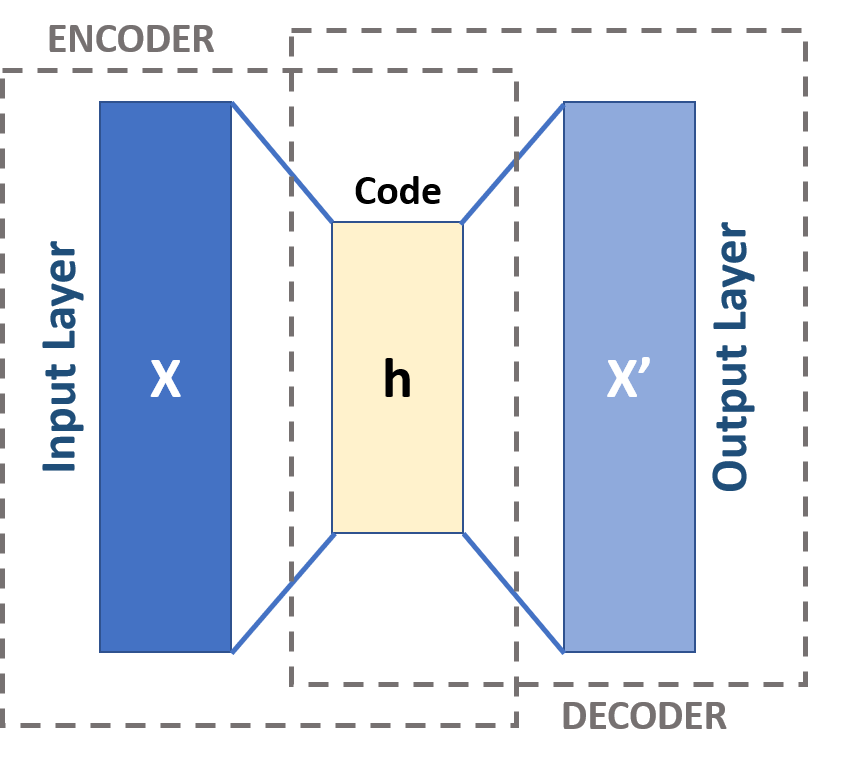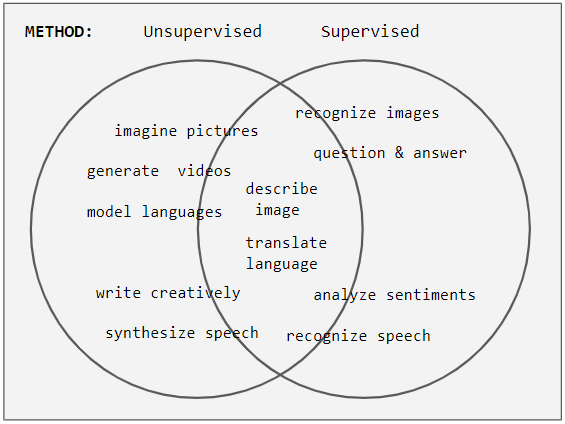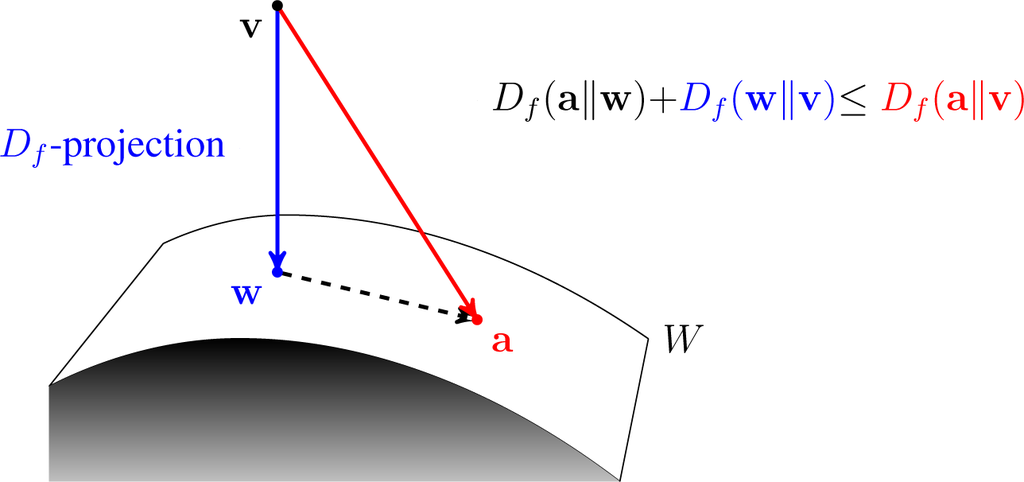|
Autoencoder
An autoencoder is a type of artificial neural network used to learn efficient codings of unlabeled data (unsupervised learning). An autoencoder learns two functions: an encoding function that transforms the input data, and a decoding function that recreates the input data from the encoded representation. The autoencoder learns an efficient representation (encoding) for a set of data, typically for dimensionality reduction, to generate lower-dimensional embeddings for subsequent use by other machine learning algorithms. Variants exist which aim to make the learned representations assume useful properties. Examples are regularized autoencoders (''sparse'', ''denoising'' and ''contractive'' autoencoders), which are effective in learning representations for subsequent classification tasks, and ''variational'' autoencoders, which can be used as generative models. Autoencoders are applied to many problems, including facial recognition, feature detection, anomaly detection, and l ... [...More Info...] [...Related Items...] OR: [Wikipedia] [Google] [Baidu] |
Variational Autoencoder
In machine learning, a variational autoencoder (VAE) is an artificial neural network architecture introduced by Diederik P. Kingma and Max Welling. It is part of the families of probabilistic graphical models and variational Bayesian methods. In addition to being seen as an autoencoder neural network architecture, variational autoencoders can also be studied within the mathematical formulation of variational Bayesian methods, connecting a neural encoder network to its decoder through a probabilistic latent space (for example, as a multivariate Gaussian distribution) that corresponds to the parameters of a variational distribution. Thus, the encoder maps each point (such as an image) from a large complex dataset into a distribution within the latent space, rather than to a single point in that space. The decoder has the opposite function, which is to map from the latent space to the input space, again according to a distribution (although in practice, noise is rarely a ... [...More Info...] [...Related Items...] OR: [Wikipedia] [Google] [Baidu] |
Unsupervised Learning
Unsupervised learning is a framework in machine learning where, in contrast to supervised learning, algorithms learn patterns exclusively from unlabeled data. Other frameworks in the spectrum of supervisions include weak- or semi-supervision, where a small portion of the data is tagged, and self-supervision. Some researchers consider self-supervised learning a form of unsupervised learning. Conceptually, unsupervised learning divides into the aspects of data, training, algorithm, and downstream applications. Typically, the dataset is harvested cheaply "in the wild", such as massive text corpus obtained by web crawling, with only minor filtering (such as Common Crawl). This compares favorably to supervised learning, where the dataset (such as the ImageNet1000) is typically constructed manually, which is much more expensive. There were algorithms designed specifically for unsupervised learning, such as clustering algorithms like k-means, dimensionality reduction techniques l ... [...More Info...] [...Related Items...] OR: [Wikipedia] [Google] [Baidu] |
Generative Model
In statistical classification, two main approaches are called the generative approach and the discriminative approach. These compute classifiers by different approaches, differing in the degree of statistical modelling. Terminology is inconsistent, but three major types can be distinguished: # A generative model is a statistical model of the joint probability distribution P(X, Y) on a given observable variable ''X'' and target variable ''Y'';: "Generative classifiers learn a model of the joint probability, p(x, y), of the inputs ''x'' and the label ''y'', and make their predictions by using Bayes rules to calculate p(y\mid x), and then picking the most likely label ''y''. A generative model can be used to "generate" random instances ( outcomes) of an observation ''x''. # A discriminative model is a model of the conditional probability P(Y\mid X = x) of the target ''Y'', given an observation ''x''. It can be used to "discriminate" the value of the target variable ''Y'', given an ... [...More Info...] [...Related Items...] OR: [Wikipedia] [Google] [Baidu] |
Feature Learning
In machine learning (ML), feature learning or representation learning is a set of techniques that allow a system to automatically discover the representations needed for feature detection or classification from raw data. This replaces manual feature engineering and allows a machine to both learn the features and use them to perform a specific task. Feature learning is motivated by the fact that ML tasks such as classification often require input that is mathematically and computationally convenient to process. However, real-world data, such as image, video, and sensor data, have not yielded to attempts to algorithmically define specific features. An alternative is to discover such features or representations through examination, without relying on explicit algorithms. Feature learning can be either supervised, unsupervised, or self-supervised: * In supervised feature learning, features are learned using labeled input data. Labeled data includes input-label pairs where the inp ... [...More Info...] [...Related Items...] OR: [Wikipedia] [Google] [Baidu] |
Anomaly Detection
In data analysis, anomaly detection (also referred to as outlier detection and sometimes as novelty detection) is generally understood to be the identification of rare items, events or observations which deviate significantly from the majority of the data and do not conform to a well defined notion of normal behavior. Such examples may arouse suspicions of being generated by a different mechanism, or appear inconsistent with the remainder of that set of data. Anomaly detection finds application in many domains including cybersecurity, medicine, machine vision, statistics, neuroscience, law enforcement and financial fraud to name only a few. Anomalies were initially searched for clear rejection or omission from the data to aid statistical analysis, for example to compute the mean or standard deviation. They were also removed to better predictions from models such as linear regression, and more recently their removal aids the performance of machine learning algorithms. However, in ... [...More Info...] [...Related Items...] OR: [Wikipedia] [Google] [Baidu] |
Activation Function
The activation function of a node in an artificial neural network is a function that calculates the output of the node based on its individual inputs and their weights. Nontrivial problems can be solved using only a few nodes if the activation function is ''nonlinear''. Modern activation functions include the logistic ( sigmoid) function used in the 2012 speech recognition model developed by Hinton et al; the ReLU used in the 2012 AlexNet computer vision model and in the 2015 ResNet model; and the smooth version of the ReLU, the GELU, which was used in the 2018 BERT model. Comparison of activation functions Aside from their empirical performance, activation functions also have different mathematical properties: ; Nonlinear: When the activation function is non-linear, then a two-layer neural network can be proven to be a universal function approximator. This is known as the Universal Approximation Theorem. The identity activation function does not satisfy this property. W ... [...More Info...] [...Related Items...] OR: [Wikipedia] [Google] [Baidu] |
Sparse Coding
Neural coding (or neural representation) is a neuroscience field concerned with characterising the hypothetical relationship between the Stimulus (physiology), stimulus and the neuronal responses, and the relationship among the Electrophysiology, electrical activities of the neurons in the Neuronal ensemble, ensemble. Based on the theory that sensory and other information is represented in the brain by Biological neural network, networks of neurons, it is believed that neurons can encode both Digital data, digital and analog signal, analog information. Overview Neurons have an ability uncommon among the cells of the body to propagate signals rapidly over large distances by generating characteristic electrical pulses called action potentials: voltage spikes that can travel down axons. Sensory neurons change their activities by firing sequences of action potentials in various temporal patterns, with the presence of external sensory stimuli, such as light, sound, taste, Olfaction, sm ... [...More Info...] [...Related Items...] OR: [Wikipedia] [Google] [Baidu] |
Variational Bayesian Methods
Variational Bayesian methods are a family of techniques for approximating intractable integrals arising in Bayesian inference and machine learning. They are typically used in complex statistical models consisting of observed variables (usually termed "data") as well as unknown parameters and latent variables, with various sorts of relationships among the three types of random variables, as might be described by a graphical model. As typical in Bayesian inference, the parameters and latent variables are grouped together as "unobserved variables". Variational Bayesian methods are primarily used for two purposes: # To provide an analytical approximation to the posterior probability of the unobserved variables, in order to do statistical inference over these variables. # To derive a lower bound for the marginal likelihood (sometimes called the ''evidence'') of the observed data (i.e. the marginal probability of the data given the model, with marginalization performed over unobserv ... [...More Info...] [...Related Items...] OR: [Wikipedia] [Google] [Baidu] |
VAE Basic
Vae or VAE may refer to: * Vae (name) * VAE Nortrak North America, a manufacturer of railroad track components * Validation des Acquis de l'Expérience, a procedure of granting degrees based on work experience in France * Variational autoencoder In machine learning, a variational autoencoder (VAE) is an artificial neural network architecture introduced by Diederik P. Kingma and Max Welling. It is part of the families of probabilistic graphical models and variational Bayesian metho ..., an artificial neural network architecture See also * * {{disambiguation ... [...More Info...] [...Related Items...] OR: [Wikipedia] [Google] [Baidu] |




